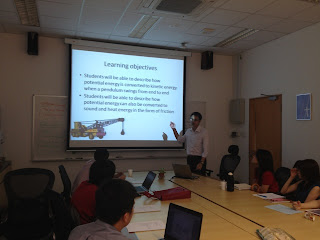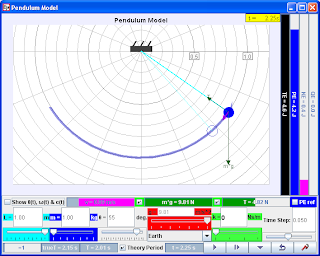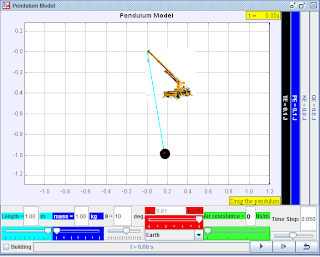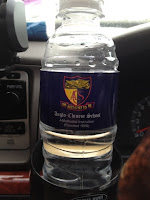http://weelookang.blogspot.sg/2012/01/sharing-at-s5-cluster-open-source.html
Briefing Document: Open Source Physics Educational Resources in Singapore
Subject: Review of "20120111 Sharing at S5 Cluster Open Source Physics Easy Java Simulations tool"
Overview:
This document analyzes a webpage from the "Open Educational Resources / Open Source Physics @ Singapore" website, specifically focusing on a sharing session from January 11, 2012, regarding the use of Easy Java Simulations (EJS) for physics education. The page highlights the accessibility, customizability, and real-world application of open-source physics simulations, particularly concerning a pendulum model, and also provides an extensive list of available resources, workshops, and projects.
Key Themes and Ideas:
- Open Educational Resources (OER) and Open Source Physics (OSP): The central theme is the promotion and utilization of freely available educational resources in physics. The website champions the use of open-source simulations, particularly those created with Easy Java Simulations (EJS), as a means of providing accessible, adaptable learning tools. The page explicitly states the benefits:
- "free (no vendor to make expensive learning objects)": This underscores the cost-effectiveness of open-source resources for educational institutions, eliminating reliance on proprietary, often costly, software.
- "real ( today can start, no need to wait for approval for school, moehq etc, write ITQ, write concept paper)": This highlights the immediate usability of these tools, bypassing bureaucratic hurdles that may delay the adoption of other resources.
- "endless ( 550+ and 2000+ computer models for you to remix)": This points to the vast library of pre-existing simulations that teachers can adapt and remix to suit specific learning needs.
- Easy Java Simulations (EJS): EJS is a core component of this OER/OSP initiative. It is presented as a tool that empowers educators to not only use existing simulations but also to modify them, and even create new ones. EJS is presented as the main technology enabler. The document states that users can "Collaborative Community of EJS (Moderator: lookang) and register , login and download all of them for free".
- Focus on the Pendulum Model: The specific sharing session detailed on this page focused on using a pendulum simulation to teach primary school students about energy concepts. The use case is detailed: "Matthew Ong leading the sharing on the scenario for Primary Science Energy concepts in Pendulum". The page references two versions of the simulation, one "Ejs Open Source Real Pendulum Model java applet" and the other a "Primary School remix for Pendulum" indicating a conscious effort to tailor the simulations for different grade levels. The existence of the remix by MattHatter further emphasizes the collaborative and adaptable nature of EJS.
- Collaborative Community and Remix Culture: The document mentions that simulations are based on work by Wolfgang Christian and F. Esquembre, and then remixed by "lookang" and "MattHatter." This highlights the collaborative nature of the OSP project and the idea of building upon the work of others. The page encourages users to join the EJS collaborative community and download resources to "remix".
- Real-World Physics & Hands-on Learning: Beyond the pendulum, the extensive list of resources demonstrates a desire to model diverse physics concepts, from mechanics and electromagnetism to wave phenomena and quantum physics. The emphasis is on visually accessible, interactive simulations. Some are even 3D, enhancing the experience. It is noteworthy that some simulations are even used to support specific educational events, such as "Tracker 6/6 Paper Square Drag to Terminal Velocity SYPT2016". There is evidence of work on adapting simulations to fit various platforms as well as levels, with clear references to Primary school and Secondary school versions of several simulations.
- Wide Range of Physics Topics and Tools The list of resources is a good illustration of the breadth and depth of simulations developed using EJS. Many simulations incorporate multimedia, and modeling techniques. These include:
- Tracker (video analysis software) with simulations
- WebGL based 3D simulations
- Various JavaScript based simulations.
- Emphasis on Pedagogical Innovation: This initiative is not just about using simulations; it's also about innovative teaching methods, as seen in the use of "Tracker as a Model-Building Pedagogical Tool" and "Becoming Scientists through Video Analysis."
- Recognition and Awards: The page includes a section listing multiple awards, including the "UNESCO King Hamad Bin Isa Al-Khalifa Prize for the Use of ICTs in Education," the "Ministry of Education Outstanding Innovator Award," and the "Public Service 21 ExCEL Awards". These recognitions underscore the significance and impact of this OER/OSP initiative in Singapore's educational landscape.
- Workshops, Events & Training: The document includes an extensive list of workshops and training events, highlighting the efforts made to train educators to use these resources. It mentions workshops conducted by experts in the field, including Prof Francisco Esquembre, Wolfgang Christian and Félix J. García Clemente, as well as Prof Fu-Kwun Hwang, which indicates that the team is actively investing in educating teachers in these resources.
Important Facts:
- Date of Sharing Session: January 11, 2012.
- Presenters: Wee Loo Kang, Matthew Ong, and Sze Yee.
- Target Audience: S5 Cluster Science Support Group Meeting, which included teachers from various schools including primary, secondary, and junior college level.
- Technology: Easy Java Simulations (EJS), Java applets, Javascript, HTML5.
- Licensing: Creative Commons Attribution 3.0 Singapore License for the work, with specific licensing for commercial use of EJS library.
- Number of Articles: 1173
- Number of Article Views: 9826863
- Number of Guests: 379
Conclusion:
The webpage demonstrates a robust and dynamic effort to promote the use of OER and OSP in Singaporean physics education. The initiative emphasizes the creation, sharing, and adaptation of interactive simulations using EJS, creating a platform for collaboration and innovation among educators. The emphasis on accessibility, real-world applications, and teacher training is noteworthy. The sheer volume of resources, workshops, and projects indicates a significant investment in transforming physics education through technology.
Next Steps:
- Further investigation into the functionality of the referenced simulations.
- Explore the EJS collaborative community and its resources.
- Examine how these resources are being implemented in actual classrooms.
- Investigate the impact of this initiative on student learning outcomes.
This briefing document provides a comprehensive overview of the key information provided in the source document. It can serve as a starting point for further research and analysis.
Sharing at S5 Cluster Open Source Physics Easy Java Simulations tool
 |
| Matthew Ong leading the sharing on the scenario for Primary Science Energy concepts in Pendulum |
 |
| Sharing at S5 Cluster Science Support Group Meeting Open Source Physics Easy Java Simulations tool |
date: 11 January 2012
time: 1530-1600
venue: Anglo-Chinese Junior
Presenter:
Wee Loo Kang
 |
| Matthew Ong sharing |
 |
| Matthew Ong leading the sharing on the scenario for Primary Science Energy concepts in Pendulum |
Sze Yee
Supt/S5
(Mdm Tan Yen Fong)
ETO: Lawrence Tan
- Anglo-Chinese Junior
- Bendemeer Pr
- Balestier Hill Pr
- Farrer Park Pr
- St Andrew’s Junior
- St Joseph’s Institution Junior
- Balestier Hill Sec
- Bendemeer Sec
- St Andrew’s Sec
- St Joseph’s Institution
- Catholic JC
- St Andrew’s JC
- School Of The Arts
Ejs Open Source Real Pendulum Model java applet
 |
| Ejs Open Source Real Pendulum Model java applet by lookang, based on works by Wolfgang Christian and F. Esquembre |
Java Simulation above is kindly hosted by NTNUJAVA Virtual Physics Laboratory by Professor Fu-Kwun Hwanghttp://www.phy.ntnu.edu.tw/ntnujava/index.php?topic=818.0
alternatively, go direct to http://www.phy.ntnu.edu.tw/ntnujava/index.php?board=28.0
Collaborative Community of EJS (Moderator: lookang) and register , login and download all of them for free :)
This work is licensed under a Creative Commons Attribution 3.0 Singapore License
Author: by Wolfgang Christian and F. Esquembre remixed version by lookang (this remix version)
Primary School remix for Pendulum
 |
| Primary School remix for Pendulum by MattHatter |
http://www.phy.ntnu.edu.tw/ntnujava/index.php?topic=2371.0
Author: by Wolfgang Christian and F. Esquembre ,lookang and slightly remixed by MattHatter (this remix version)
The possibilities are
- free (no vendor to make expensive learning objects),
- real ( today can start, no need to wait for approval for school, moehq etc, write ITQ, write concept paper)
- endless ( 550+ and 2000+ computer models for you to remix)
Another great pendulum tool by PhET
http://phet.colorado.edu/sims/pendulum-lab/pendulum-lab_en.jar
 |
| water bottle from ACS junior
|
FAQ
- What is Open Source Physics (OSP) and what does it offer educators?
- Open Source Physics (OSP) is a movement focused on providing free and accessible educational resources, particularly in physics, through the use of open-source tools and simulations. This approach eliminates the need for expensive proprietary software and allows for the free use, adaptation, and sharing of resources. It provides teachers with immediate access to a large library of simulations, eliminating lengthy approval processes. The OSP materials are designed to be realistic and adaptable, allowing teachers to tailor the models to specific learning objectives and diverse student needs. Educators can utilize these resources without cost and without barriers of typical vendor approvals, making them accessible to a wide range of educators.
- What is Easy Java/JavaScript Simulations (EJS/EJSS) and how does it relate to OSP?
- Easy Java/JavaScript Simulations (EJS/EJSS) is an authoring tool that allows educators to create interactive simulations and computer models. EJS/EJSS is a significant enabler of the OSP movement by facilitating the development and customization of physics simulations and other educational interactive resources. It allows educators to adapt and modify existing simulations to suit different learning environments and student levels. The tool enables teachers to construct models and use them as a basis for inquiry-based lessons. Many of the OSP simulations mentioned in the source material are made using EJS, making it a key piece of the infrastructure for creating and sharing these free resources. The move to JavaScript based simulations allows access via web browsers without specific software requirements.
- What types of simulations are available through OSP, and for what educational levels?
- The OSP resources include a diverse range of simulations covering various physics concepts, as well as resources for math, chemistry, and other subjects. Examples listed include: Newtonian mechanics, oscillations, pendulums, radioactive decay, electromagnetism, sound waves, kinematics, projectile motion, and even the solar system. These simulations are designed for a range of educational levels, from primary school to junior college (high school) levels. The models are often available in both primary school and secondary school versions, highlighting the adaptability of the resources. The available resources include models ranging from simple physical motion and forces to more complex models covering electricity and optics and the periodic table.
- How are these open-source simulations being implemented in schools in Singapore?
- The provided material shows how the open source physics simulations are being shared among teachers in Singapore through workshops, cluster meetings, and professional development sessions. Teachers are trained to use the authoring tools and shown how to adapt existing models to suit their curriculum needs. The materials show that workshops are conducted for teachers and the tools are shown to be useful for a variety of subjects. The workshops and collaborations also emphasize collaborative remixing and modifying of resources. This demonstrates a grass-roots effort by committed educators to improve education through freely available simulations and resources.
- What are the advantages of using these open source simulations in education?
- The main advantages of using these open-source simulations are their cost, adaptability, and accessibility. OSP simulations are free, which eliminates vendor costs and lengthy approval procedures for schools. They are "real", allowing educators to start using them immediately, without bureaucratic delays. The resources are also "endless", providing access to a massive collection of customizable models. The simulations encourage students to engage in hands-on learning, where they actively participate in manipulating variables and observing results. They promote inquiry-based learning, allowing students to investigate physics concepts rather than passively receiving information.
- What role does collaborative remixing play in the use of OSP materials?
- Collaborative remixing is a core principle of OSP. Educators are encouraged to adapt, modify, and share simulations that have been created by others, as evidenced by phrases such as "remixed version" being frequently used in the source materials. This collaborative approach allows the OSP library to grow exponentially as teachers create new versions and extensions for their needs. It avoids teachers having to start models from scratch and it allows for community improvements. This philosophy promotes active engagement with the source material, as well as provides a more meaningful resource for a diversity of educational contexts.
- What other tools are being used along with OSP and EJS/EJSS?
- In addition to EJS/EJSS, other tools such as Tracker video analysis software and PhET simulations are also mentioned as integral components for creating an integrated learning experience. Tracker allows for the analysis of real-world videos, allowing for real data to be compared with simulations. PhET provides another source of interactive simulations. The integration of these different tools promotes both exploration and real-world connection in science education. Desmos is also mentioned as a tool for mathematics education and shows the breadth of the tools and resources being explored.
- What is the licensing and sharing model for these OSP resources?
- The OSP resources are typically licensed under Creative Commons licenses such as Attribution 3.0 or 4.0 Singapore, which permits free use and sharing of the content with proper attribution. While most resources are freely available under these licenses, commercial use may require contacting the relevant license holder. This ensures that while resources can be shared and adapted, they retain proper attribution and copyright. The license also includes a "Share Alike" component, requiring derivative works to be licensed similarly. The source also notes that the core library is available via a commercial license if needed.
